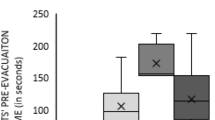Abstract
One way to avoid the loss of life in building fires is by performing effective evacuation. As a consequence of economic developments, cities of the world continuously build high-rise buildings, including super high-rise ones having more than 40 storeys. When a building has to perform full evacuation, the long travel distance in a super high-rise building can cause delay to reach exit discharge locations on the ground floor. Although a number of studies have been carried out to identify the characteristics of evacuee during emergency, it is suggested that the evacuation behaviour may be affected by cultural background of the persons (Özkaya A 2001) [1]. This paper is intended to gather building evacuation time, vertical movement speed data and to study the behaviour of occupants during evacuation in medium- and high-rise buildings. The study was carried out mostly in Jakarta, Indonesia. The evacuation time and overall movement speed were observed by gathering the data during a typical evacuation drill in the medium- and high-rise buildings. The result suggested that vertical movement speed descending from the fourth floor is around 0.70–0.81 m/s. As the evacuee is descending from the higher floors, the lower movement speed was identified, e.g. around 0.62–0.75 m/s for those descending from the ninth floor and around 0.50–0.73 m/s for those descending from 19th floor. The trends are in good agreement with other works suggested in the literature. From the surveys, regardless of the occupancy, i.e. whether the building is an office, a college or shopping avenue, interesting behaviours of the evacuee during evacuation process were identified. While travelling downwards, evacuees tend to evacuate in groups, to walk side by side with other members of the groups, and some of them hold the stairs’ railing. These caused queuing and congestion, especially if the exit stairs’ width only fit two people walking side by side.
Access this chapter
Tax calculation will be finalised at checkout
Purchases are for personal use only
Similar content being viewed by others
References
Özkaya A (2001) A qualitative approach to children of developing countries from human behaviour in fire aspect, human behaviour in fire. Proceedings of the second international symposium, Interscience Communications, London, pp 531–538, pp 533–534
Sujatmiko W, Dipojono HK, Soelami FXN, Soegijanto (2014) Performance-based fire safety evacuation in high-rise building flats in Indonesia – a case study in Bandung. Procedia Environ Sci 20:116–125
Ma J, Song WG, Tian W, Lo SM, Liao GX (2012) Experimental study on an ultra high-rise building evacuation in China. Saf Sci 50:1665–1674, p. 1668
The Society of Fire Protection Engineers (2002) SFPE handbook of fire protection engineering, 3rd edn. National Fire Protection Association, Quincy, pp 3–367
Kobes M, Helsloot I, de Vries B, Post JG, Oberije’ N, Groenewegen K (2010) Way finding during fire evacuation; an analysis of unannounced fire drills in a hotel at night. Build Environ 45:537–548
Jeon G-Y, Kim J-Y, Hong W-H, Augenbroe G (2011) Evacuation performance of individuals in different visibility conditions. Build Environ 46:1094–1103
Koo J, Kim YS, Kim B-I, Christensen KM (2013) A comparative study of evacuation strategies for people with disabilities in high-rise building evacuation, Expert Sys Appl 40(2013):408–417
Shaobo L, Lizhong Y, Tingyong F, Jian L (2009) Evacuation from a classroom considering the occupant density around exits. Physica A 388(2009):1921–1928
Nagai R, Fukamachi M, Nagatani T (2006) Evacuation of crawlers and walkers from corridor through an exit. Physica A 367:449–460
Liu M, Zheng X, Cheng Y (2011) Determining the effective distance of emergency evacuation signs. Fire Saf J 46:364–369
Tanimoto J, Hagishima A, Tanaka Y (2010) Study of bottleneck effect at an emergency evacuation exit using cellular automata model, mean field approximation analysis, and game theory. Physica A 389:5611–5618
Frank GA, Dorso CO (2011) Room evacuation in the presence of an obstacle. Physica A 390:2135–2145
Guyl ne Proulx (1995) Evacuation time and movement in apartment buildings. Fire Saf J 24:229–246
Cote’ R, Harrington GE (2006) Life safety code handbooks. National Fire Protection Association, Quincy
Kady RA, Davis J (2008) The effect of occupant characteristics on crawling speed in evacuation. Fire Saf J 44(2009):451–457
Kuligowski E, Peacock R, Wiess E, Hoskins B (2013) Stair evacuation of older adults and people with mobility impairments. Fire Saf J 62:230–237
Spearpoint M, MacLennan HA (2012) The effect of an ageing and less fit population on the ability of people to egress buildings. Saf Sci 50:1675–1684
Xu X, Song W (2009) Staircase evacuation modeling and its comparison with an egress drill. Build Environ 44:1039–1046
Fang Z, Song W, Zhang J, Wu H (2010) Experiment and modeling of exit-selecting behaviors during a building evacuation. Physica A 389:815–824
Shields TJ, Boyce KE (2000) A study of evacuation from large retail stores. Fire Saf J 35:25–49
The Society of Fire Protection Engineers (2002) SFPE handbook of fire protection engineering, 3rd edn. National Fire Protection Association, Quincy, pp 3–346
The Society of Fire Protection Engineers (2002) SFPE handbook of fire protection engineering, 3rd edn. National Fire Protection Association, Quincy, pp 3–363
Koo J, Kim B-I, Kim YS (2014) Estimating the effects of mental disorientation and physical fatigue in a semi-panic evacuation. Expert Systems Appl 41(2014):2379–2390, p. 2383
Acknowledgements
The authors would like to thank Pemerintah DKI Jakarta, Indonesia, and Dinas Penanggulangan Kebakaran dan Penyelamatan for providing scholarships as well as their support during the data collection and discussion.
Author information
Authors and Affiliations
Corresponding author
Editor information
Editors and Affiliations
Rights and permissions
Copyright information
© 2017 Springer Science+Business Media Singapore
About this paper
Cite this paper
Leonita, F., Sakti, H., Nugroho, Y.S. (2017). Study of the Occupant Characteristics During Evacuation in Medium- and High-Rise Buildings in Indonesia. In: Harada, K., Matsuyama, K., Himoto, K., Nakamura, Y., Wakatsuki, K. (eds) Fire Science and Technology 2015. Springer, Singapore. https://doi.org/10.1007/978-981-10-0376-9_12
Download citation
DOI: https://doi.org/10.1007/978-981-10-0376-9_12
Published:
Publisher Name: Springer, Singapore
Print ISBN: 978-981-10-0375-2
Online ISBN: 978-981-10-0376-9
eBook Packages: EngineeringEngineering (R0)




